 Technology peripherals
Technology peripherals
 AI
AI
 How does AI-powered Windows shape the future? Microsoft chief product officer gives his understanding
How does AI-powered Windows shape the future? Microsoft chief product officer gives his understanding
How does AI-powered Windows shape the future? Microsoft chief product officer gives his understanding
May 25th: On Wednesday, local time, the second highlight of Microsoft's annual developer conference was staged. Microsoft Chief Product Officer Panos Panai took the stage to demonstrate to the world "the Windows operating system that will shape the future."
Panai stood in the audience and replayed the Windows Copilot demonstration video shown by Microsoft CEO Nadella yesterday. Facing the expressionless audience, Panay said: "For people in this room, it is very natural to be able to use AI, Bing, and ChatGPT, but for more people, they have only heard of this Things, just like when we tried to understand what the Internet was like."
Because these users are not familiar with Windows settings and features, they cannot give instructions to the AI. Because of this, Microsoft's Windows Copilot will not only respond to users' needs, but will also proactively guess what functions users may need and proactively provide users with a series of options.
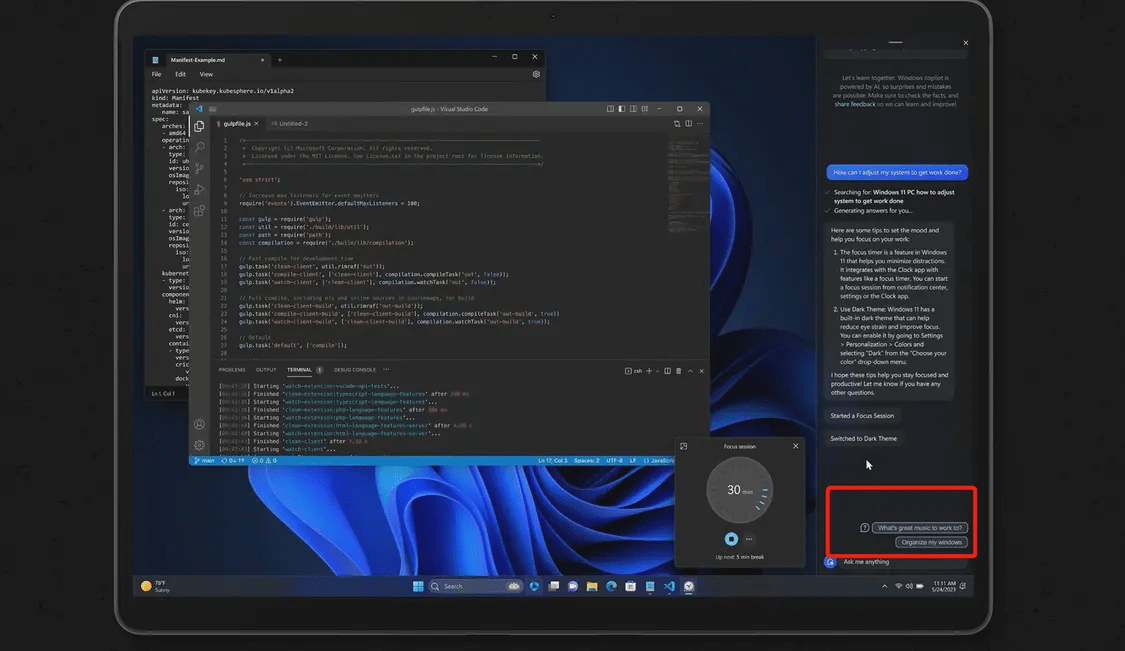
(Pay attention to the prompt box in the lower right corner, source: live video)
Another example is that the user can select a piece of text in Notepad and send it to Windows Copilot. Then the AI will actively ask whether it needs to "explain", "rewrite" or "summarize" the paragraph.
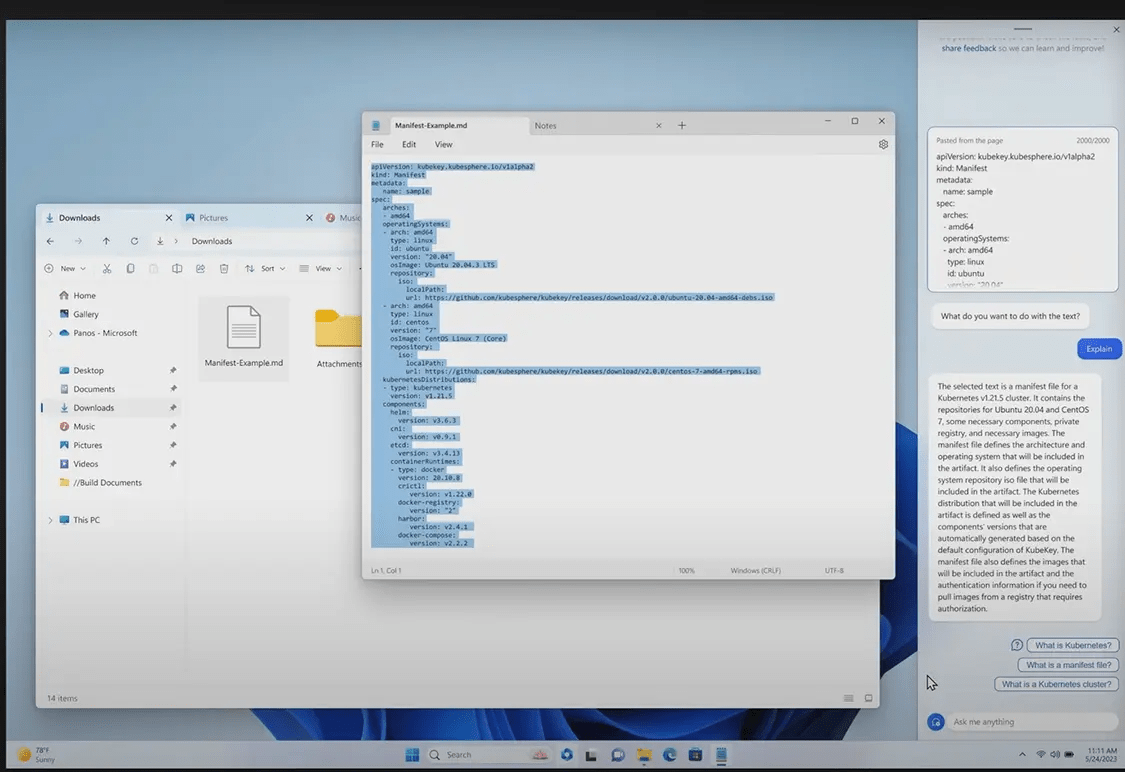
(Source: live video)
The same thing applies to audio. Users can drop the recording into the sidebar and then ask AI to transcribe and translate the text.
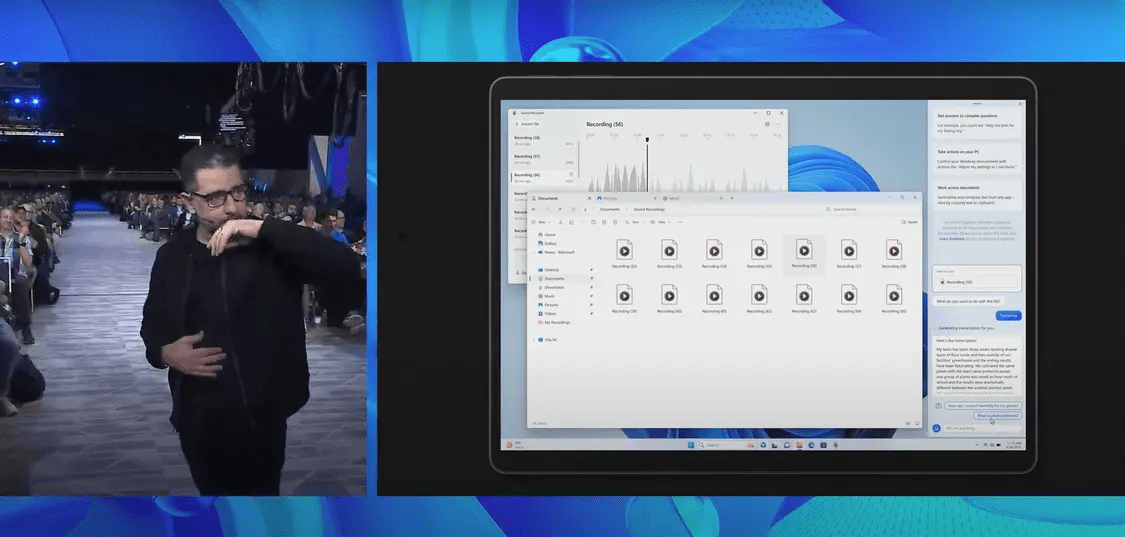
(Source: live video)
Of course, this is just the beginning for AI to reshape the narrative of human use of computer systems.
Panay pointed out that Microsoft has been emphasizing various plug-ins recently, but in fact, the current Windows platform can already support the most complex AI applications. For developers, that day is almost here, and Windows Copilot will appear on preview versions of Windows 11 in June.
Internet giants, who have always had a keen sense of smell, have already begun a new round of layout. Panay said that software including Spotify, Snapchat, and Facebook Messenger have all entered Microsoft’s PC App Store. You must know that these software were just mobile application software two years ago. The emergence of AI has brought more possibilities to people. Now they only need to use a computer to continue their workflow, and their mobile phones can be placed in their pockets.
Also present at Wednesday’s meeting was Will Cathcart, director of Meta’s messaging app WhatsApp. As the world's largest messaging software, WhatsApp is collaborating with Microsoft to provide a new messaging experience for large-screen devices. Thanks to improvements in computing power, the PC version of WhatsApp video calls can now offer a variety of features including background blur.

(Source: live video)
Microsoft released the developer control center Dev Home this week, which is very important for key developers in the AI application ecosystem. Simply put, this tool can help developers set up and use Windows for software development more conveniently, including setting up a development environment for the machine, connecting to GitHub and related repositories, installing tools, etc. This tool naturally integrates with GitHub Copilot, a Microsoft product, with the ability to write code, fix errors, and add comments.
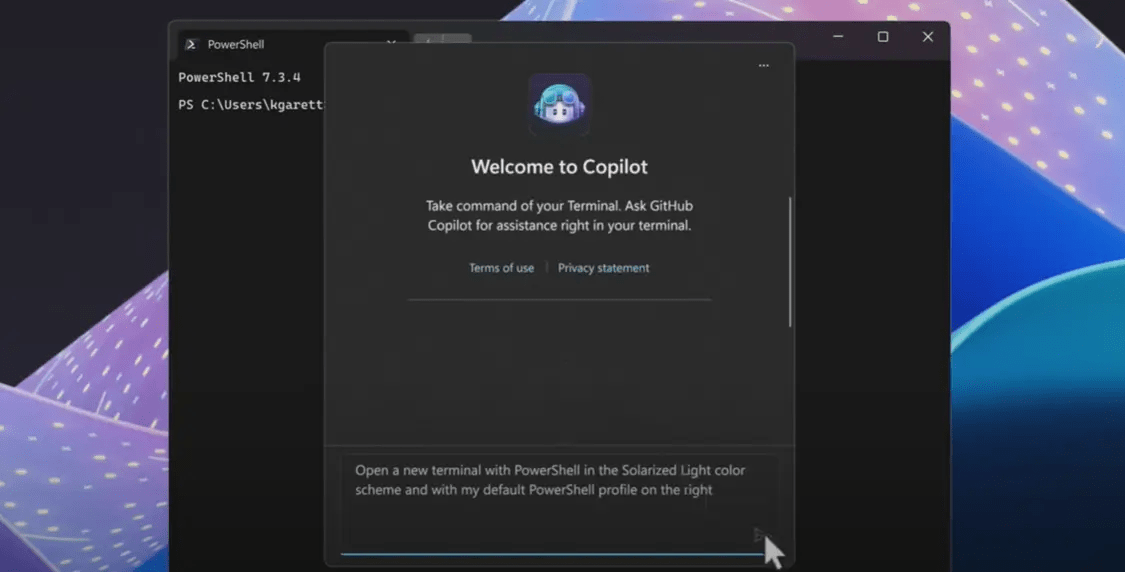
(Source: live video)
Microsoft also provides developers with a series of tools to integrate Copilot into their own software in various forms.
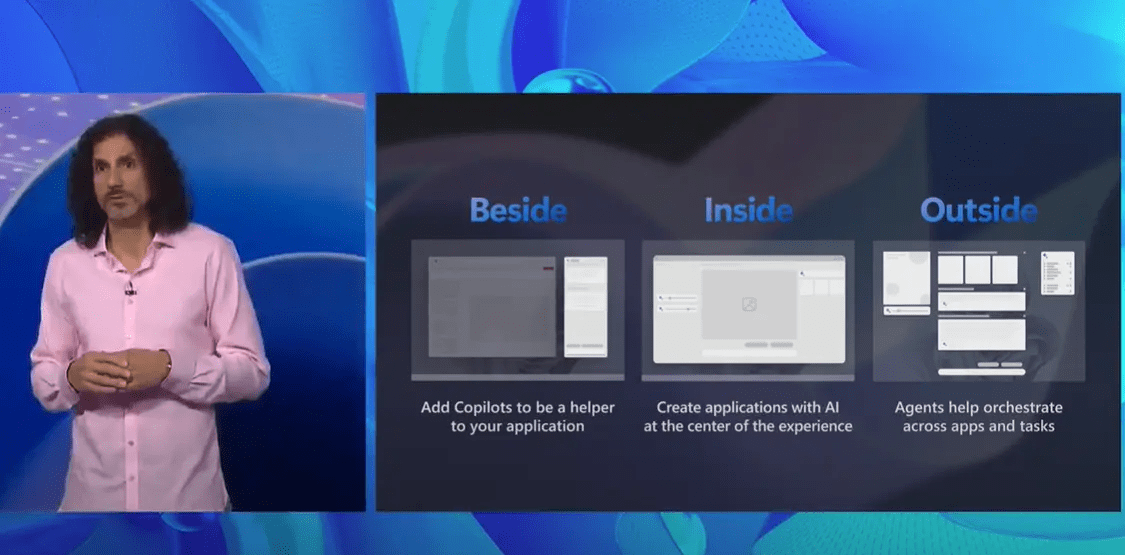
(Source: live video)
At Wednesday’s press conference, Microsoft also announced some new features, including Restore, which can help users “reinstall all apps with one click” after installing a new machine, and a summary of App Store user reviews powered by AI. In addition, Microsoft will also launch AI Hub on the App Store in the near future to show users what a series of AI applications can do, thereby motivating more people to start their AI journey.
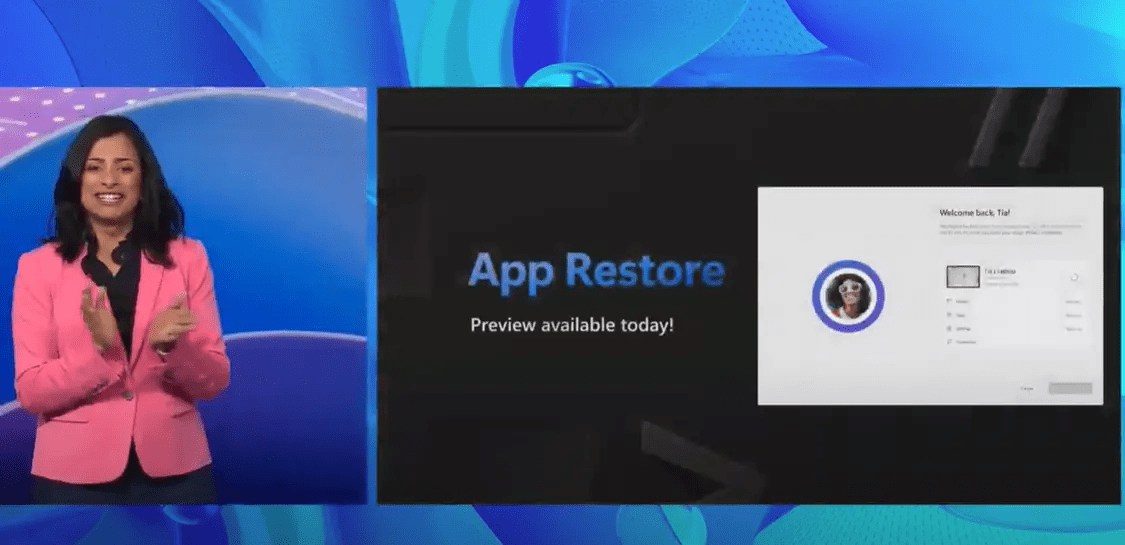

(Source: live video)
It is worth mentioning that before Panai’s debut, Microsoft’s product team also demonstrated a series of new features of 365 Copilot, including Microsoft Mesh spanning AI, Metaverse, VR and other concepts. Previously, Microsoft has launched the "Virtual Avatar" function, which uses avatars to help workers in front of the camera work more freely.

(Source: live video)
And Mesh goes a step further and directly enters the category of the metaverse. At the same time, Microsoft has also helped many well-known institutions around the world create exclusive virtual online spaces.


(Source: live video)
However, like Meta's Horizon Worlds, Microsoft's "Metaverse Avatar" is also only half-body, which at least shows that the current level of AI is not enough to solve the "too ugly" problem of the Metaverse.
[Source: Financial Associated Press]
The above is the detailed content of How does AI-powered Windows shape the future? Microsoft chief product officer gives his understanding. For more information, please follow other related articles on the PHP Chinese website!

Hot AI Tools

Undresser.AI Undress
AI-powered app for creating realistic nude photos

AI Clothes Remover
Online AI tool for removing clothes from photos.

Undress AI Tool
Undress images for free

Clothoff.io
AI clothes remover

Video Face Swap
Swap faces in any video effortlessly with our completely free AI face swap tool!

Hot Article

Hot Tools

Notepad++7.3.1
Easy-to-use and free code editor

SublimeText3 Chinese version
Chinese version, very easy to use

Zend Studio 13.0.1
Powerful PHP integrated development environment

Dreamweaver CS6
Visual web development tools

SublimeText3 Mac version
God-level code editing software (SublimeText3)

Hot Topics
 1666
1666
 14
14
 1425
1425
 52
52
 1325
1325
 25
25
 1272
1272
 29
29
 1252
1252
 24
24
 How to use the chrono library in C?
Apr 28, 2025 pm 10:18 PM
How to use the chrono library in C?
Apr 28, 2025 pm 10:18 PM
Using the chrono library in C can allow you to control time and time intervals more accurately. Let's explore the charm of this library. C's chrono library is part of the standard library, which provides a modern way to deal with time and time intervals. For programmers who have suffered from time.h and ctime, chrono is undoubtedly a boon. It not only improves the readability and maintainability of the code, but also provides higher accuracy and flexibility. Let's start with the basics. The chrono library mainly includes the following key components: std::chrono::system_clock: represents the system clock, used to obtain the current time. std::chron
 How to understand DMA operations in C?
Apr 28, 2025 pm 10:09 PM
How to understand DMA operations in C?
Apr 28, 2025 pm 10:09 PM
DMA in C refers to DirectMemoryAccess, a direct memory access technology, allowing hardware devices to directly transmit data to memory without CPU intervention. 1) DMA operation is highly dependent on hardware devices and drivers, and the implementation method varies from system to system. 2) Direct access to memory may bring security risks, and the correctness and security of the code must be ensured. 3) DMA can improve performance, but improper use may lead to degradation of system performance. Through practice and learning, we can master the skills of using DMA and maximize its effectiveness in scenarios such as high-speed data transmission and real-time signal processing.
 How to handle high DPI display in C?
Apr 28, 2025 pm 09:57 PM
How to handle high DPI display in C?
Apr 28, 2025 pm 09:57 PM
Handling high DPI display in C can be achieved through the following steps: 1) Understand DPI and scaling, use the operating system API to obtain DPI information and adjust the graphics output; 2) Handle cross-platform compatibility, use cross-platform graphics libraries such as SDL or Qt; 3) Perform performance optimization, improve performance through cache, hardware acceleration, and dynamic adjustment of the details level; 4) Solve common problems, such as blurred text and interface elements are too small, and solve by correctly applying DPI scaling.
 What is real-time operating system programming in C?
Apr 28, 2025 pm 10:15 PM
What is real-time operating system programming in C?
Apr 28, 2025 pm 10:15 PM
C performs well in real-time operating system (RTOS) programming, providing efficient execution efficiency and precise time management. 1) C Meet the needs of RTOS through direct operation of hardware resources and efficient memory management. 2) Using object-oriented features, C can design a flexible task scheduling system. 3) C supports efficient interrupt processing, but dynamic memory allocation and exception processing must be avoided to ensure real-time. 4) Template programming and inline functions help in performance optimization. 5) In practical applications, C can be used to implement an efficient logging system.
 How to measure thread performance in C?
Apr 28, 2025 pm 10:21 PM
How to measure thread performance in C?
Apr 28, 2025 pm 10:21 PM
Measuring thread performance in C can use the timing tools, performance analysis tools, and custom timers in the standard library. 1. Use the library to measure execution time. 2. Use gprof for performance analysis. The steps include adding the -pg option during compilation, running the program to generate a gmon.out file, and generating a performance report. 3. Use Valgrind's Callgrind module to perform more detailed analysis. The steps include running the program to generate the callgrind.out file and viewing the results using kcachegrind. 4. Custom timers can flexibly measure the execution time of a specific code segment. These methods help to fully understand thread performance and optimize code.
 Steps to add and delete fields to MySQL tables
Apr 29, 2025 pm 04:15 PM
Steps to add and delete fields to MySQL tables
Apr 29, 2025 pm 04:15 PM
In MySQL, add fields using ALTERTABLEtable_nameADDCOLUMNnew_columnVARCHAR(255)AFTERexisting_column, delete fields using ALTERTABLEtable_nameDROPCOLUMNcolumn_to_drop. When adding fields, you need to specify a location to optimize query performance and data structure; before deleting fields, you need to confirm that the operation is irreversible; modifying table structure using online DDL, backup data, test environment, and low-load time periods is performance optimization and best practice.
 Quantitative Exchange Ranking 2025 Top 10 Recommendations for Digital Currency Quantitative Trading APPs
Apr 30, 2025 pm 07:24 PM
Quantitative Exchange Ranking 2025 Top 10 Recommendations for Digital Currency Quantitative Trading APPs
Apr 30, 2025 pm 07:24 PM
The built-in quantization tools on the exchange include: 1. Binance: Provides Binance Futures quantitative module, low handling fees, and supports AI-assisted transactions. 2. OKX (Ouyi): Supports multi-account management and intelligent order routing, and provides institutional-level risk control. The independent quantitative strategy platforms include: 3. 3Commas: drag-and-drop strategy generator, suitable for multi-platform hedging arbitrage. 4. Quadency: Professional-level algorithm strategy library, supporting customized risk thresholds. 5. Pionex: Built-in 16 preset strategy, low transaction fee. Vertical domain tools include: 6. Cryptohopper: cloud-based quantitative platform, supporting 150 technical indicators. 7. Bitsgap:
 How to use string streams in C?
Apr 28, 2025 pm 09:12 PM
How to use string streams in C?
Apr 28, 2025 pm 09:12 PM
The main steps and precautions for using string streams in C are as follows: 1. Create an output string stream and convert data, such as converting integers into strings. 2. Apply to serialization of complex data structures, such as converting vector into strings. 3. Pay attention to performance issues and avoid frequent use of string streams when processing large amounts of data. You can consider using the append method of std::string. 4. Pay attention to memory management and avoid frequent creation and destruction of string stream objects. You can reuse or use std::stringstream.



